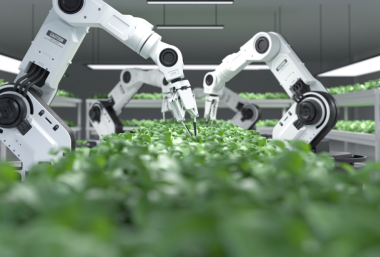Climate change presents significant challenges to traditional outdoor farming. Extreme weather events such as droughts, floods, and erratic temperature fluctuations have become more frequent, leading to crop failures, reduced yields, and economic losses. These challenges necessitate a shift toward more resilient and adaptive methods of food production, and vertical indoor farming may provide a key part of the solution.
The global population has reached 8 billion and is projected to rise to 8.5 billion by 2030 and 9.7 billion by 20501. With an ever-increasing human population comes an ever-increasing appetite and necessity for food. To meet this demand, it is estimated a doubling of global agricultural production by 20502 is necessary.
Fundamentally, farming methods haven’t changed for centuries and continue to extensively use resources such as land, water, energy, heavy machinery, fertilisers and pesticides – to grow our food. According to the World Resources Report: Creating a Sustainable Food Future3, 50% of the world’s vegetated land is being used for agriculture, consuming 90% of the water used by humanity. Such a large environmental footprint on an already resource-constrained world could limit the expansion of conventional agriculture to feed the world.

Traditional farming. Source: World Resources Report3
Traditional farming in an outdoor environment also faces the challenges of extreme and variable weather conditions as well as pest infestations4, which can affect yields and food production for farmers. Extreme weather events such as droughts and flooding have been known to cause widespread destruction of crops, resulting in billions of dollars5 of damage. The effects of these events touch the entire food supply chain through supply chain disruption, food insecurity and consumer price inflation.
Vertical indoor farming - part of the solution
As with many emerging technologies, patent filing statistics are a good indicator of the investment being made in research and development in a sector and vertical indoor farming is a sector that is 'on the rise' in more ways than one.
Vertical indoor farming involves the growth of crops in a closed, controlled and monitored environment, and is emerging as a viable and sustainable solution to ensure food security and mitigate the impact of climate change.
Vertical indoor crop farming provides significant benefits over conventional farming techniques:
- Optimised resource utilisation: Vertical indoor farms utilise limited space efficiently by stacking crops vertically, thus maximising yield per square foot. This approach allows for higher crop density and a reduced land footprint, making it suitable for urban environments where land availability is limited.
- Weather independence: By cultivating crops indoors, vertical farming eliminates dependence on favourable weather conditions. Controlled environments ensure stable temperatures, humidity levels, and lighting, minimising the risk of crop damage due to extreme weather events.
- Water efficiency: Vertical farms employ advanced irrigation systems such as hydroponics or aeroponics, which significantly reduce water usage compared to traditional farming methods. Recirculating systems and precise nutrient delivery enable water conservation and mitigate the impact of droughts.
- Year-round production: Traditional farming is often seasonal, limiting the availability and variety of fresh produce. Vertical indoor farming enables year-round production, providing a consistent and reliable supply of fresh food regardless of external climatic conditions.
- Reduced carbon footprint: Vertical indoor farming minimises transportation distances, as crops can be grown closer to urban centres, reducing carbon emissions associated with long-distance transportation. Additionally, the controlled environment reduces the need for pesticides and fertilisers, further lowering the environmental impact.
- Enhanced crop quality and yield: Vertical farming creates an optimised environment for crops, enabling precise control over light, temperature, and nutrient levels. This precision results in faster growth rates, higher crop yields, and improved product quality compared to traditional farming methods.
- Pest and disease control: By growing crops indoors, vertical farms are better equipped to control pests and diseases. Isolation from external pests and the ability to closely monitor plant health reduces the need for chemical pesticides, making vertical farming a more sustainable and environmentally friendly approach.
- Land preservation: Vertical farming reduces the demand for arable land, allowing agricultural land to be preserved or used for other purposes such as reforestation or wildlife conservation. This contributes to the overall sustainability and preservation of natural ecosystems.
According to a report by Research and Markets6, the valuation of the global indoor farming market is expected to increase by over 40% (almost USD 25 billion in 2027, up from USD 14.3 billion in 2020).

Indoor Farming Market. Source: Research and Markets6

Vertical Farming. Source: Wikipedia7
Technology to the fore
To achieve an optimum controlled growth condition, vertical farming is highly dependent on technology and automation to control and integrate different systems such as lighting, water recycling, temperature and humidity regulation, production and distribution chain. Robotics are also commonly employed, and artificial intelligence (AI) has increasingly become integral to further increase the production efficiency of vertical farms.
Light intensity, wavelength, and illumination period are important in plant growth. In vertical farming, LED lighting gives plants the light they need to grow year-round. The LED lighting can be controlled to synchronise with the growth stage of the plants, affecting their growth rate and nutrient contents, thereby improving production yield and quality. Furthermore, the ability to seamlessly switch the light spectrum to cater to different plant types enables specific plants to be cultivated when needed to meet seasonal demands.
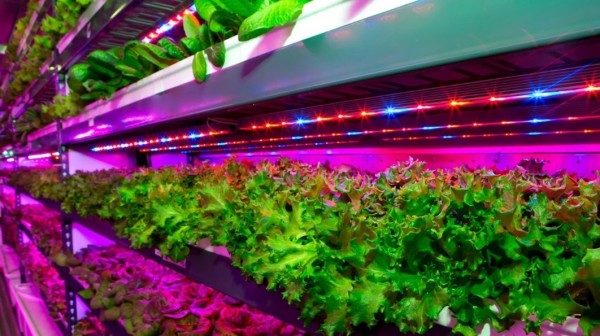
Use of LED lighting in vertical farming. Source: Culture Trip9
Temperature, humidity level and air circulation are regulated to create the optimum indoor climate for vertically farmed produce. These act together to maintain the right humidity level around the plants, disperse excess heat and manage airflow and CO2 to the plants. Misalignment of these factors with the plants’ requirements could adversely affect the growth rate of the plants, affect the plants’ root networks, and potentially lead to the growth of harmful organisms, such as fungus, that could be detrimental to the health of the growing plants.
To monitor crop growth and the environment, a network of sensors is deployed in vertical farming to capture data on various parameters such as light spectrum, temperature, humidity, growth rates, CO2, energy consumption, water consumption, nutrient level, etc. With the vast amount of data collected, data analytics technology can be used to study the growth conditions for the plants to increase efficiencies, optimise conditions and improve yields.
Cultivating a large amount of produce stacked high in multilayer structures requires using automation to manage the multitude of systems for plant production. This requires complex hardware and software modules that speak to each other to manage the entire process from preparation of growth medium to harvesting. Such an automation system typically also receives inputs from the complex network of sensors to make real-time adjustments to the growth environment if needed. The use of automation reduces workforce costs while increasing productivity and precision.
A recent patent application that implements these technologies was filed by Silo Farms LLC (US 2021/0007304). The application describes a high rise building with plurality of very tall spiral conveyors. Seedlings are continuously loaded onto each conveyor at the top and gradually pass through optimised watering, nutrient and LED zones that simulate day and night, during their journey down the spiral. Being enclosed the plants are isolated from insects, the weather and pollution and several days later emerge at the bottom of the spiral ready to be packed and shipped to nearby supermarket shelves. Carbon dioxide emitted from growing mushrooms for example, can be easily collected and re-used.
The role of intellectual property in agri-innovation
Companies continue to innovate to improve their products and processes, and the same applies in the vertical farming industry. To remain at the fore, there is an ongoing requirement for organisations to conduct research and development to drive new innovation and scale their businesses.
As an emerging area, the potential for companies to grow their intangible assets in the vertical farming space is huge. Patent filing for their new technologies can protect their innovations and prevent other parties from using them without their permission. This has the potential to amplify an innovator’s first-mover advantage. Companies can also leverage their intangible assets to licence their technologies to other parties, providing a potential lucrative revenue stream.
A patent search can be conducted to get an insight into global research and development activity. This is because patent publications are usually the first sign of commercial intent by companies with new innovations.
Figure 1 shows the patent filing trend worldwide from 2012-2022. Starting from just 18 filings in 2012, the number of patent families being filed in the sector has increased steadily over the 10-year period to reach 303 filings in 2021. This is in addition to the many thousands of patents for LED light technology.
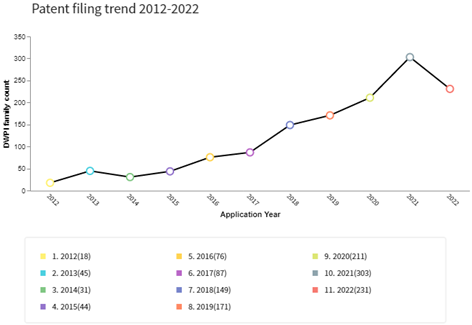
Figure 1: Worldwide patent filing trend for vertical farming (2012-2022)
Figure 2 shows a world map illustrating the countries (in green) with patent filings in the industry. Most of the filings are concentrated in countries in the Americas, Europe, and the Asia-Oceania region.
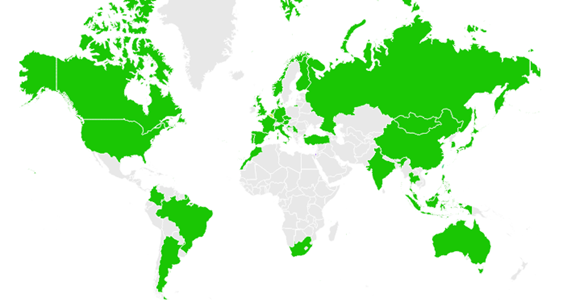
Figure 2: World map highlighting countries with existing patent filings for vertical farming (2012-2022)
Figure 3 shows the top ten patent filings by country. The US has the most patent filing with 426 filings, followed by China (CN) with 160 filings, and Korea (KR) with 120 filings. The bar chart of Figure 3 also shows an active IP scene in the industry in India (IN), Europe (EP), Japan (JP), Canada (CA), Taiwan (TW), the UK (GB), and Singapore (SG).
Figure 3: Top ten filing countries for vertical farming (2012-2022)
Figure 4 shows the top ten patent filings by applicant/assignee, with US firms holding 4 of the top 5 spots.
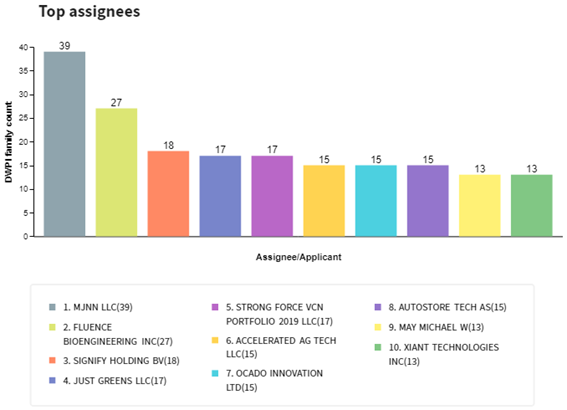
Figure 4: Top ten filings by assignee for vertical farming (2012-2022)
With the myriad of technologies employed in the vertical farming industry, there is great scope for innovation and IP protection, which can form a key strategic asset to help industry players thrive.
Get in touch to find out more about protecting your assets.
1 World Population Prospects 2022, Population Division of the Department of Economic and Social Affairs of the United Nations Secretariat [online] [Accessed 18 April 2023]
2 A Five-Step Plan to Feed the World, National Geographic Magazine [online] [Accessed 18 April 2023]
3 World Resources Report: Creating a Sustainable Food Future [online] [Accessed 18 April 2023]
4 Locusts are putting 5 million people at risk of starvation – and that’s without COVID-19, World Economic Forum [online] [Accessed 21 April 2023]
5 Damage and loss, Food and Agriculture Organization of the United Nations [online] [Accessed 21 April 2023]
6 Indoor Farming Market, Research and Markets [online] [Accessed 21 April 2023]
7 Vertical farming, Wikipedia [online] [Accessed 21 April 2023]
8 How Sustainable is Vertical Farming? Students Try to Answer the Question, Columbia Climate School [online] [Accessed 21 April 2023]
9 How This City Is Developing a Farm in the Heart of the Desert, Culture Trip [online] [Accessed 27 April 2023]
